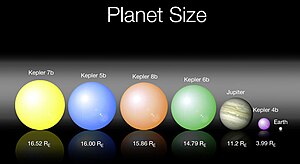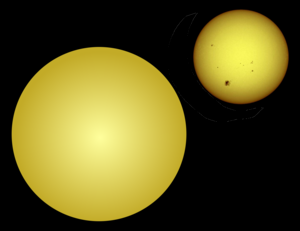Kepler-7
| Observation data Epoch J2000 Equinox J2000 | |
|---|---|
| Constellation | Lyra |
| Right ascension | 19h 14m 19.5623s[1] |
| Declination | +41° 05′ 23.367″[1] |
| Apparent magnitude (V) | 13.005±0.039[2] |
| Characteristics | |
| Spectral type | G0[3] |
| Apparent magnitude (J) | 11.833±0.020[4] |
| Apparent magnitude (H) | 11.601±0.022[4] |
| Apparent magnitude (K) | 11.535±0.020[4] |
| Apparent magnitude (B) | 13.620±0.029[2] |
| Astrometry | |
| Radial velocity (Rv) | +0.40 ± 0.10[5] km/s |
| Proper motion (μ) | RA: −2.937(15) mas/yr[1] Dec.: −21.084(14) mas/yr[1] |
| Parallax (π) | 1.0319 ± 0.0121 mas[1] |
| Distance | 3,160 ± 40 ly (970 ± 10 pc) |
| Details[5] | |
| Mass | 1.347+0.072 −0.054 M☉ |
| Radius | 1.843+0.048 −0.066 R☉ |
| Luminosity | 4.15+0.63 −0.54 L☉ |
| Surface gravity (log g) | 3.98 ± 0.10 cgs |
| Temperature | 5933 ± 44 K |
| Metallicity [Fe/H] | +0.11 ± 0.03 dex |
| Rotational velocity (v sin i) | 4.2 ± 0.5 km/s |
| Age | 3.3 ± 0.4 Gyr |
| Other designations | |
| Database references | |
| SIMBAD | data |
Kepler-7 is a star located in the constellation Lyra in the field of view of the Kepler Mission, a NASA operation in search of Earth-like planets. It is home to the fourth of the first five planets that Kepler discovered; this planet, a Jupiter-size gas giant named Kepler-7b, is as light as styrofoam.[6] The star itself is more massive than the Sun, and is nearly twice the Sun's radius. It is also slightly metal-rich, a major factor in the formation of planetary systems. Kepler-7's planet was presented on January 4, 2010 at a meeting of the American Astronomical Society.
Nomenclature and discovery[edit]
Kepler-7 received its name because it was the home to the seventh planetary system discovered by the NASA-led Kepler Mission, a project aimed at detecting terrestrial planets that transit, or pass in front of, their host stars as seen from Earth.[7] The planet orbiting Kepler-7 was the fourth planet to be discovered by the Kepler spacecraft; the first three planets combed from Kepler's data had been previously discovered, and were used to verify the accuracy of Kepler's measurements.[8] Kepler-7b was announced to the public on January 4, 2010 at the 215th meeting of the American Astronomical Society in Washington, D.C. along with Kepler-4b, Kepler-5b, Kepler-6b, and Kepler-8b. Kepler-7b was noted for its unusually and extremely low density.[6]
The planet's initial discovery by Kepler was verified by additional observations made at observatories in Hawaii, Texas, Arizona, California, and the Canary Islands.[9]
Characteristics[edit]
Kepler-7 is a sunlike star that is 1.347 Msun and 1.843 Rsun. This means that the star is about 35% more massive and 84% wider than the Sun. The star is estimated to be 3.5 (± 1) billion years old. It is also estimated to have a metallicity of [Fe/H] = 0.11 (± 0.03), meaning that Kepler-7 is approximately 30% more metal-rich than the Sun; metallicity plays a significant role in the formation of planetary systems, as metal-rich stars tend to be more likely to have planets in orbit.[10] The star's effective temperature is 5933 (± 44) K.[11] In comparison, the 4.6 billion-year-old Sun[12] releases less heat, with an effective temperature of 5778 K.[13]

The star has an apparent magnitude of 13,[2] meaning that it is extremely dim as seen from Earth. It cannot be seen with the naked eye.[8] It is estimated to lie at approximately 3160 light years from the Solar System.[1]
There is a star that is 4 magnitudes dimmer located 1.90 arcseconds away, whether this a gravitationally bound companion star or a chance optical alignment is unknown.[14]
Planetary system[edit]
Kepler-7b is the only planet that has been discovered in Kepler-7's orbit. It is .433 MJ and 1.478 RJ, meaning it is 43% the mass of planet Jupiter, but is nearly three halves its size. With a density of .166 grams/cc,[8] the planet is approximately 17% the density of water. This is comparable to styrofoam.[6] At a distance of .06224 AU from its host star, Kepler-7b completes an orbit around Kepler-7 every 4.8855 days.[8] Planet Mercury, however, orbits the Sun at .3871 AU, and takes approximately 87.97 days to complete one orbit.[15] Kepler-7b's eccentricity is assumed to be 0, which would give Kepler-7b a circular orbit by definition.[8]
| Companion (in order from star) |
Mass | Semimajor axis (AU) |
Orbital period (days) |
Eccentricity | Inclination | Radius |
|---|---|---|---|---|---|---|
| b | 0.433 MJ | 0.06224 | 4.8855 | 0 | — | 1.478 RJ |
See also[edit]
References[edit]
- ^ a b c d e Vallenari, A.; et al. (Gaia collaboration) (2023). "Gaia Data Release 3. Summary of the content and survey properties". Astronomy and Astrophysics. 674: A1. arXiv:2208.00211. Bibcode:2023A&A...674A...1G. doi:10.1051/0004-6361/202243940. S2CID 244398875. Gaia DR3 record for this source at VizieR.
- ^ a b c Henden, A. A.; et al. (2016). "VizieR Online Data Catalog: AAVSO Photometric All Sky Survey (APASS) DR9 (Henden+, 2016)". VizieR On-line Data Catalog: II/336. Originally Published in: 2015AAS...22533616H. 2336. Bibcode:2016yCat.2336....0H.Vizier catalog entry
- ^ a b "Kepler-7". SIMBAD. Centre de données astronomiques de Strasbourg. Retrieved 2018-11-24.
- ^ a b c Skrutskie, Michael F.; Cutri, Roc M.; Stiening, Rae; Weinberg, Martin D.; Schneider, Stephen E.; Carpenter, John M.; Beichman, Charles A.; Capps, Richard W.; Chester, Thomas; Elias, Jonathan H.; Huchra, John P.; Liebert, James W.; Lonsdale, Carol J.; Monet, David G.; Price, Stephan; Seitzer, Patrick; Jarrett, Thomas H.; Kirkpatrick, J. Davy; Gizis, John E.; Howard, Elizabeth V.; Evans, Tracey E.; Fowler, John W.; Fullmer, Linda; Hurt, Robert L.; Light, Robert M.; Kopan, Eugene L.; Marsh, Kenneth A.; McCallon, Howard L.; Tam, Robert; Van Dyk, Schuyler D.; Wheelock, Sherry L. (1 February 2006). "The Two Micron All Sky Survey (2MASS)". The Astronomical Journal. 131 (2): 1163–1183. Bibcode:2006AJ....131.1163S. doi:10.1086/498708. ISSN 0004-6256. S2CID 18913331. Vizier catalog entry
- ^ a b Latham, David W.; et al. (2010). "Kepler-7b: A Transiting Planet with Unusually Low Density". The Astrophysical Journal. 713 (2): L140–L144. arXiv:1001.0190. Bibcode:2010ApJ...713L.140L. doi:10.1088/2041-8205/713/2/L140.
- ^ a b c Rich Talcott (5 January 2010). "215th AAS meeting update: Kepler discoveries the talk of the town". Astronomy.com. Astronomy magazine. Retrieved 27 February 2011.
- ^ Johnson, Michele, ed. (2018-10-30). "Mission overview". www.nasa.gov. NASA. Retrieved 2018-11-24.
- ^ a b c d e f "Summary Table of Kepler Discoveries". NASA. 2010-01-04. Archived from the original on 2010-05-27. Retrieved 2010-01-06.
- ^ "NASA's Kepler Space Telescope Discovers its First Five Exoplanets". NASA. 4 January 2010. Retrieved 27 February 2011.
- ^ Henry Bortman (12 October 2004). "Extrasolar Planets: A Matter of Metallicity". Space Daily. Retrieved 27 February 2011.
- ^ "Notes for star Kepler-7". Extrasolar Planets Encyclopaedia. 2010. Archived from the original on 21 January 2011. Retrieved 27 February 2011.
- ^ Fraser Cain (16 September 2008). "How Old is the Sun?". Universe Today. Retrieved 27 February 2011.
- ^ David Williams (1 September 2004). "Sun Fact Sheet". Goddard Space Flight Center. NASA. Retrieved 27 February 2011.
- ^ Hirsch, Lea A.; et al. (2017). "Assessing the Effect of Stellar Companions from High-resolution Imaging of Kepler Objects of Interest". The Astronomical Journal. 153 (3). 117. arXiv:1701.06577. Bibcode:2017AJ....153..117H. doi:10.3847/1538-3881/153/3/117.
- ^ David Williams (17 November 2010). "Mercury Fact Sheet". Goddard Space Flight Center. NASA. Retrieved 27 February 2011.
External links[edit]
Boyle, Alan (30 September 2013). "How astronomers mapped the patchy clouds of an alien world". NBC News. Retrieved 3 October 2013.

